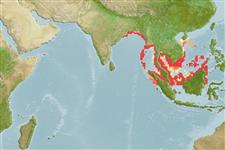>
Clupeiformes (Herrings) >
Dorosomatidae (Gizzard shads and sardinellas)
Etymology: Anodontostoma: Greek, ana = up + Greek, odous = teeth + Greek, stoma = mouth (Ref. 45335).
Environment: milieu / climate zone / depth range / distribution range
Écologie
marin; saumâtre; anadrome (Ref. 51243); profondeur 0 - 50 m (Ref. 188). Tropical; 24°N - 0°N, 85°E - 119°E (Ref. 188)
Indo-Pacific: Indian Ocean (northern part of Bay of Bengal, Andaman Sea at Phuket in Thailand), Gulf of Thailand, South China Sea. Also found in Indonesia (Ref. 7050). In earlier works, Anodontostoma chacunda was often misapplied to Anodontostoma thailandiae.
Taille / Poids / Âge
Maturity: Lm ? range ? - ? cm
Max length : 18.0 cm SL mâle / non sexé; (Ref. 188); common length : 12.0 cm SL mâle / non sexé; (Ref. 188)
Épines dorsales (Total) : 0; Épines anales: 0; Rayons mous anaux: 17 - 25. Body depth increasing with size. Second supra-maxilla paddle-shaped. Lower gill rakers 46 to 140; longest gill rakers on lower part of arch equal to or longer than corresponding gill filaments. Last dorsal fin ray not filamentous. Hind edges of scales toothed, the teeth wider than gaps between them; a median series pre-dorsal scales. A large dark mark behind gill opening.
Occurs inshore and probably entering estuaries. Its biology is probably similar to A. chacunda.
Life cycle and mating behavior
Maturité | Reproduction | Frai | Œufs | Fécondité | Larves
Whitehead, P.J.P., 1985. FAO Species Catalogue. Vol. 7. Clupeoid fishes of the world (suborder Clupeoidei). An annotated and illustrated catalogue of the herrings, sardines, pilchards, sprats, shads, anchovies and wolf-herrings. FAO Fish. Synop. 125(7/1):1-303. Rome: FAO. (Ref. 188)
Statut dans la liste rouge de l'IUCN (Ref. 130435: Version 2024-1)
Menace pour l'homme
Harmless
Utilisations par l'homme
Pêcheries: pêcheries vivrières
Outils
Articles particuliers
Télécharger en XML
Sources Internet
Estimates based on models
Preferred temperature (Ref.
123201): 27.6 - 29.3, mean 28.8 °C (based on 370 cells).
Phylogenetic diversity index (Ref.
82804): PD
50 = 0.6250 [Uniqueness, from 0.5 = low to 2.0 = high].
Bayesian length-weight: a=0.00871 (0.00415 - 0.01826), b=3.06 (2.89 - 3.23), in cm total length, based on LWR estimates for this (Sub)family-body shape (Ref.
93245).
Niveau trophique (Ref.
69278): 3.1 ±0.3 se; based on size and trophs of closest relatives
Résilience (Ref.
120179): Haut, temps minimum de doublement de population inférieur à 15 mois (Preliminary K or Fecundity.).
Fishing Vulnerability (Ref.
59153): Low vulnerability (12 of 100).
